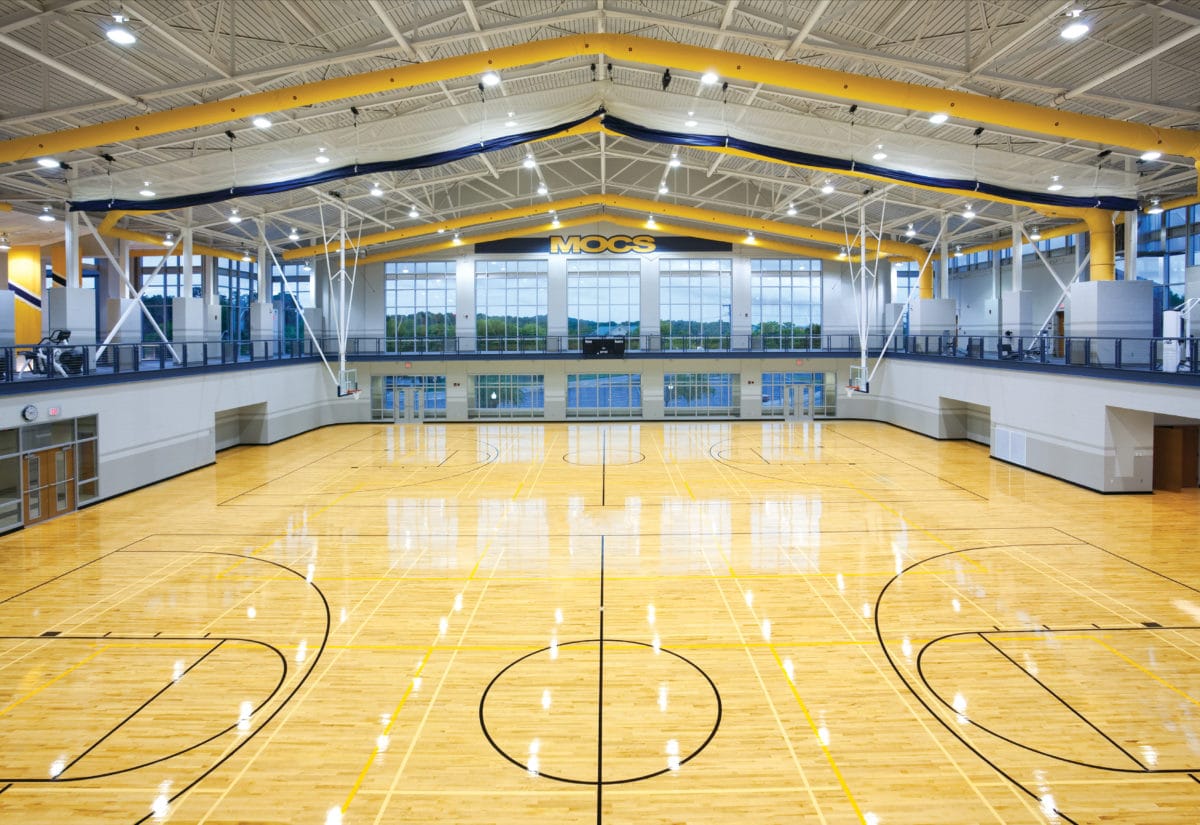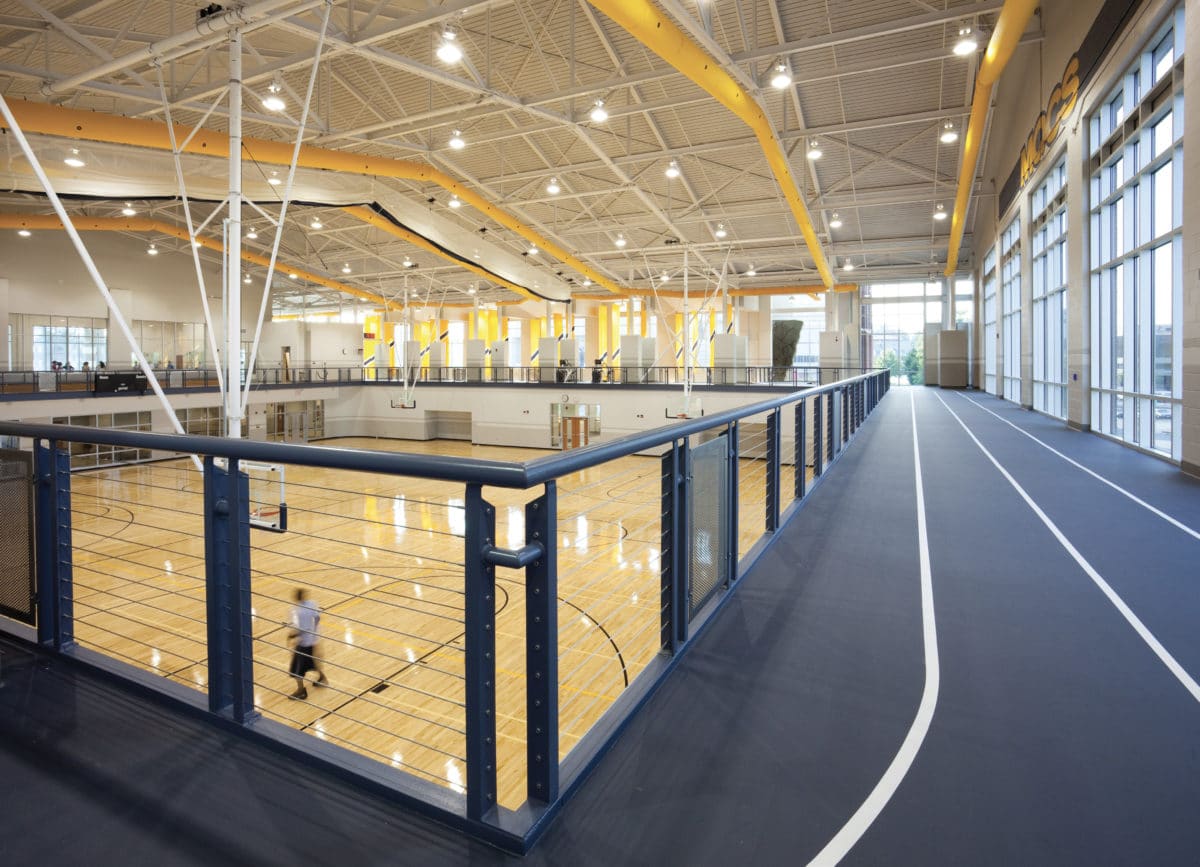Action Floor Systems leads the industry in high-performance flooring that’s sustainable, innovative, and evolutionary.

Action Floors’ sustainable flooring solutions incorporate recycled-content elements and use natural rubber resilient pads made from an environmentally friendly process. [Photo: Larry Finchum]
She suits up—pulling a jersey over her head, lacing up her sneakers, maybe strapping on a brace or tugging on a sweatband—and grabs a basketball, stepping onto the court. She’s already in the zone, already visualizing victory—and almost certainly not thinking of the solid, gleaming, high-performance flooring system beneath her feet. That’s Action Floors’ job.
For 30 years, the experts and engineers at Action Floor Systems in Mercer, Wisconsin, have been devoted to developing and designing exceptional flooring systems that are not only safe for athletes and end users, but healthy for the environment as well.
The Sweet Spot
In the U.S., maple is by far the preferred floor surface for basketball, volleyball, racquetball, squash, aerobic and dance studios, and even performance stages. And maple flooring is—and always has been—the core of Action Floors’ business. In fact, President Tom Abendroth, an Action Floors founder, is a fourth-generation industry pro. “Maple is the only hardwood product we mill—we specialize in maple flooring,” says Abendroth, who adds that it’s the wood’s light color that makes it the leading choice, lending itself to superb game line and graphics visibility. Of course, the cell structure of hard maple is also ideal, allowing for the flexibility a flooring system needs to achieve high-performance shock absorption and bounce. “Maple’s in that sweet spot,” Abendroth says. “It’s hard to beat.”
The hardwood also happens to be inherently sustainable—though the positive environmental impact of maple harvesting is not always obvious. “There’s a lot of misunderstanding and confusion about the harvesting, logging, and cutting of trees, especially when it comes to hardwoods, which are naturally renewable,” Abendroth says. Hardwoods are harvested through closely managed programs where mature trees are selectively cut from large plots of land, opening the canopy and allowing for better airflow and more sunlight. “It promotes the growth of saplings and less mature trees, so those younger trees can flourish,” Abendroth explains. “Plus, all hardwoods—particularly maples—essentially replant themselves, so they are continuously regenerating.”
As sourcing sustainable materials has become more of an industry focus, the Action Floors team sought to prove it already fully supported sustainability initiatives. So the company started achieving industry certifications and underwent independent third-party verifications, like a Life Cycle Assessment conducted by the University of Wisconsin, to evaluate its environmental impacts, which ultimately resulted in Action Floors earning carbon negative certification.
FROM OUR JANUARY+FEBRUARY 2018 ISSUE
The preferred publication of leading green professionals.

[Photo: Larry Finchum]
Sustainable Flooring Solutions
Producing the best maple sports surfaces will always be Action Floors’ primary focus, though the company has also transformed itself into a leading manufacturer of sustainable high-performance flooring systems. “Most people walk into a gym and see a nice wood floor—most don’t realize what’s underneath,” says Technical Director Don Brown. “We take great pride in the environmentally sustainable system underneath.”
Action Floors incorporates recycled-content elements within its systems and happens to be one of the few (if not only) athletic flooring companies that uses natural rubber resilient pads made from an environmentally friendly process where rubber tree sap is collected and then vulcanized to deliver superior shock absorption. The sustainably conscious flooring company also utilizes low-energy production measures and recycles its wood waste to provide steam for milling, reducing its need for fossil fuels.
A leader in sustainability initiatives, Action Floors chooses to go beyond simply claiming environmental responsibility. “Most companies within the industry strive for these standards, but most aren’t as proactive or at the same level as Action Floors,” Brown says. Through independent third-party verifications and their own company-based SCORES program (or Sustainable Construction of Renewable Engineered Surfaces), the company constantly strives to minimize its environmental impact in every aspect of the manufacturing process. This program measures the company’s use of resources and materials, energy consumption, and carbon footprint, to name a few. It encourages customers to source flooring systems from a zero-waste mill and purchase those that utilize Forest Stewardship Council–certified maple. By using the SCORES program, Action Floors has proven its high-performance floor systems are engineered to support sustainability and green building efforts.

Action Floors continues to develop and engineer outstanding athletic floor systems, like this one at UW-River Falls. [Photo: Kathy M. Helgeson]
Healthy Building
Action Floors’ commitment to sustainability hasn’t faltered in 30 years. In fact, the company is more proactive than ever in its commitment to accountability and transparency. They’ve committed to staying transparent by offering the architectural community AIA Continuing Education programs, which enables Action Floors to provide up-to-date information while showcasing their sustainability efforts. The company also recently released an Environmental Product Declaration (EPD) that, from the forest to the floor, looks at Action Floors’ overall production facility—what products are made of, the manufacturing process, and their impact on the environment.
What dramatically separates Action Floors from its competitors, however, is that the company’s goals have always been multifaceted. They aimed to achieve the highest sustainability and healthy building materials standards while simultaneously developing and engineering outstanding athletic floor systems that are healthy and safe.
From exceptional sports floor installations at Northern Kentucky University and University of Wisconsin–River Falls to outstanding high-performance applications around the world, Action Floor Systems is committed to healthy building. “A building’s health is going to become more and more important as studies continue to show how all products used in construction can contribute or take away,” Abendroth says. “And Action Floors is just on the tip of the iceberg.”
Scoring Where it Counts
You know those “fresh paint” smells? They’re not necessarily all good—in fact, what you’re smelling may be volatile organic compound (VOC) emissions from newly installed floors. That’s why, even when the experts at Action Floors are engineering what goes on the ground, they’re also always considering what goes into the air. And that’s also why Action Floors decided to seek—and recently achieve—FloorScore® certification to validate emissions from their hardwood products are low to zero and continue the company’s commitment to healthy building and sustainability.
Action Floors has undergone extensive testing, from the handling of its raw materials to manufacturing and quality control— ultimately meeting the certification’s rigorous indoor air quality requirements. “It’s a phenomenal story—that we can talk to an architect or work with an owner and say, ‘Here are the steps we’ve taken to confirm our products are safe and healthy.’ They don’t have to be concerned about the health impact of our floor systems because FloorScore® proves the low to zero emission rates are safe,” says Vice President of Sales Ron Fenhaus.
Learn about Action Floor Systems and read more gb&d flooring stories.

